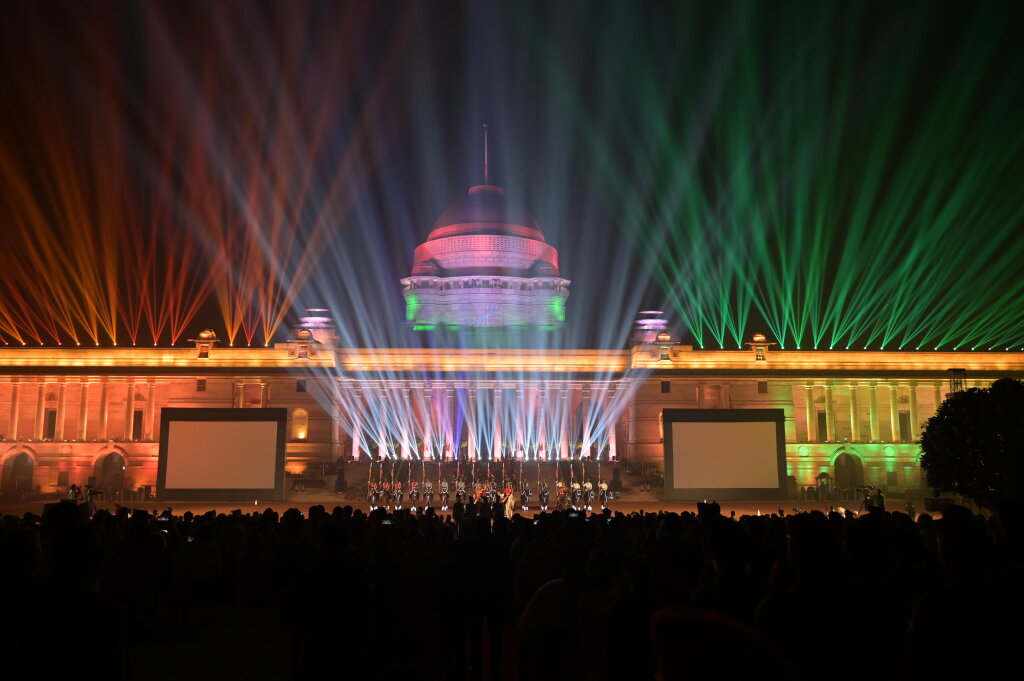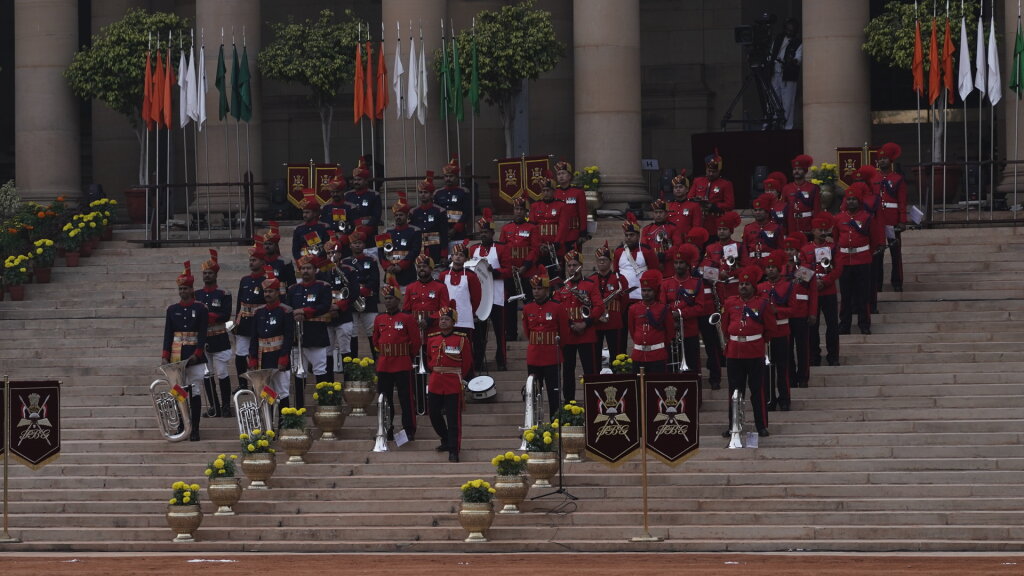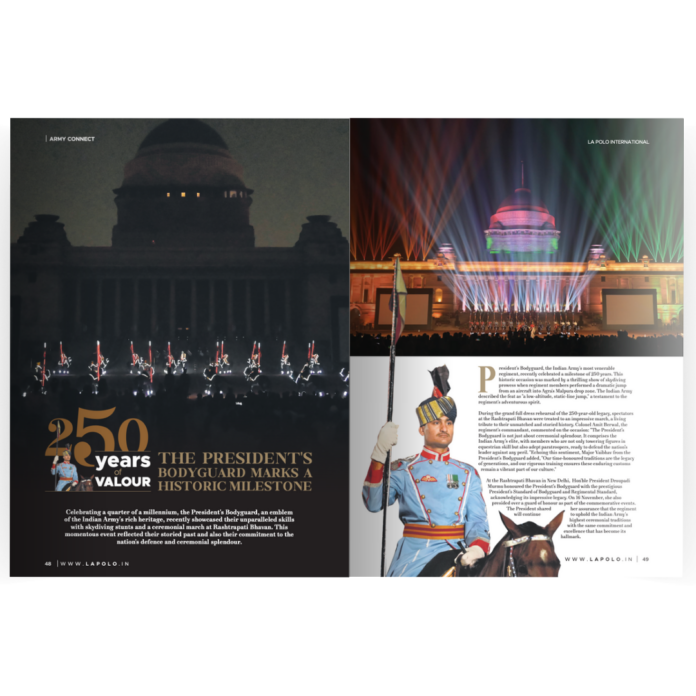The President’s Bodyguard, the Indian Army’s most venerable regiment, recently celebrated a milestone of 250 years. This historic occasion was marked by a thrilling exhibition of skydiving prowess when regiment members performed a dramatic jump from an aircraft into Agra’s Malpura drop zone. The Indian Army described the feat as “a low-altitude, static-line jump,” a testament to the regiment’s adventurous spirit.
During the grand full dress rehearsal of the 250-year-old legacy, spectators at the Rashtrapati Bhavan were treated to an impressive march, a living tribute to their unmatched and storied history. Colonel Amit Berwal, the regiment’s commandant, commented on the occasion: “The President’s Bodyguard is not just about ceremonial splendour. It comprises the Indian Army’s elite, with members who are not only towering figures in equestrian skill but also adept paratroopers, ready to defend the nation’s leader against any peril.”
Echoing this sentiment, Major Vaibhav from the Presidential Bodyguard added, “Our time-honoured traditions are the legacy of generations, and our rigorous training ensures these enduring customs remain a vibrant part of our culture.”

At the Rashtrapati Bhavan in New Delhi, President Droupadi Murmu honoured the President’s Bodyguard with the prestigious President’s Standard of Bodyguard and Regimental Standard, acknowledging its impressive legacy. On 16 November, she also presided over a guard of honour as part of the commemorative events. The President shared her assurance that the regiment will continue to uphold the Indian Army’s highest ceremonial traditions with the same commitment and excellence that has become its hallmark.
At present, the President’s Bodyguard escorts and protects the President of India. Given its close association with the President, the regiment is based out of the Rashtrpati Bhavan. While the regiment is primarily known for discharging ceremonial obligations on dates of national importance, it is also known for discharging combat obligations when deemed necessary—with members being trained to lead in airborne assaults as pathfinders. As a combat regiment, it has been equipped with BTR-80 vehicles for use on-field.
At the celebratory parade on 16 November, the President’s Bodyguard put on an elaborate showcase, highlighting its rich, resplendent legacy. As the past and present confluenced on the threshold of the Rashtrapati Bhavan, the atmosphere was ripe with patriotic passion. Along with the President, a packed audience at the stands cheered on as the regiment undertook the parade, putting on tantalising show-jumping and fire-spitting exhibits. During the parade—as is tradition—the regiment paid tribute to the nation’s fallen soldiers in honour of their sacrifice. With tri-coloured lights draped over the Rashprati Bhavan and trumpet-sprinkled notes of music, it was an occasion for the pages of history.

Brief history
A post-Independence era successor of the Governor General’s Bodyguard of the British Raj, the President’s Bodyguard was established in 1773 by Warren Hastings, the first Governor General of India (Bengal). The regiment followed in the footsteps of the deeply embedded cavalry culture in the country fostered by the British Raj’s predecessor, the Mughal Empire, considered infallible and indomitable by historians like Irfan Habib.
To create the regiment, Hastings is said to have recruited from the Moghal Horse. Additional recruits were offered by Maharaja Chait Singh of Benares. As per archival records, the regiment’s first commander was Captain Sweeny Toone, an officer of the East India Company, with Lieutenant Samuel Black serving as his assistant. At the time, it was composed of one Captain, one Lieutenant, four Sergeants, six Daffadars, 100 Troopers, two Trumpeters and one Farrier. At present, the President’s Bodyguard comprises seven officers, 15 junior commissioned officers, and 140 enlisted men, making up a total of 180 members. Right from British times, the commanding officer has always been either a brigadier or a colonel. The President’s Bodyguard is open for recruitment to only Hindu Jats, Rajputs and Jat Sikh castes—with each being taken in equal numbers from the states of Punjab, Haryana and Rajasthan.
During the partition of the country, the British Indian Army was split into two different portions, with two-thirds of it being given to the Dominion of India and one-third to the Dominion of Pakistan. Consequently, members of the President’s regiment were also split. While Mulism members were transferred to the Pakitan Army, non-Muslim members (mostly Hindus and Sikhs) were transferred to the Indian Army. On 26 January 1950, the regiment was renamed from Governor-General’s Bodyguard to President’s Bodyguard when India became a republic.
As a combat regiment, the President’s Bodyguard has witnessed Independent India’s major wars. The senior-most regiment in the order of precedence of the units of the Indian Army, it was deployed in the defense of Chushul at above 14,000 feet during the 1962 Sino-Indian War. It also participated in Operation Ablaze in the Indo-Pakistani War of 1965. A detachment of the regiment has also been involved with the Indian Peace Keeping Force mission to Sri Lanka, Somalia, Angola and Sierra Leone.

Governorial and Presidential Banner
The President’s Bodyguard has a storied history of receiving tokens of appreciation from the highest offices of the land, with Governors in the British era and Presidents post-independence honouring the regiment’s service. During the British period, each outgoing Governor would bequeath a banner, a symbol of their time served, to the regiment. This banner would be ceremonially passed on to the regiment by the incoming Governor.
This ritual has endured, albeit with modifications following India’s Independence and Partition. The traditional coat-of-arms on the banner was replaced with the President’s monogram, now embossed on a silver trumpet and accompanied by a banner. The inaugural silver trumpet and banner, bequeathed by President Rajendra Prasad, featured a rich maroon background with the Presidential seal intricately woven in gold thread. The banner was further adorned with the President’s initials in Devanagari script at the centre, flanked by golden emblems at each corner.




